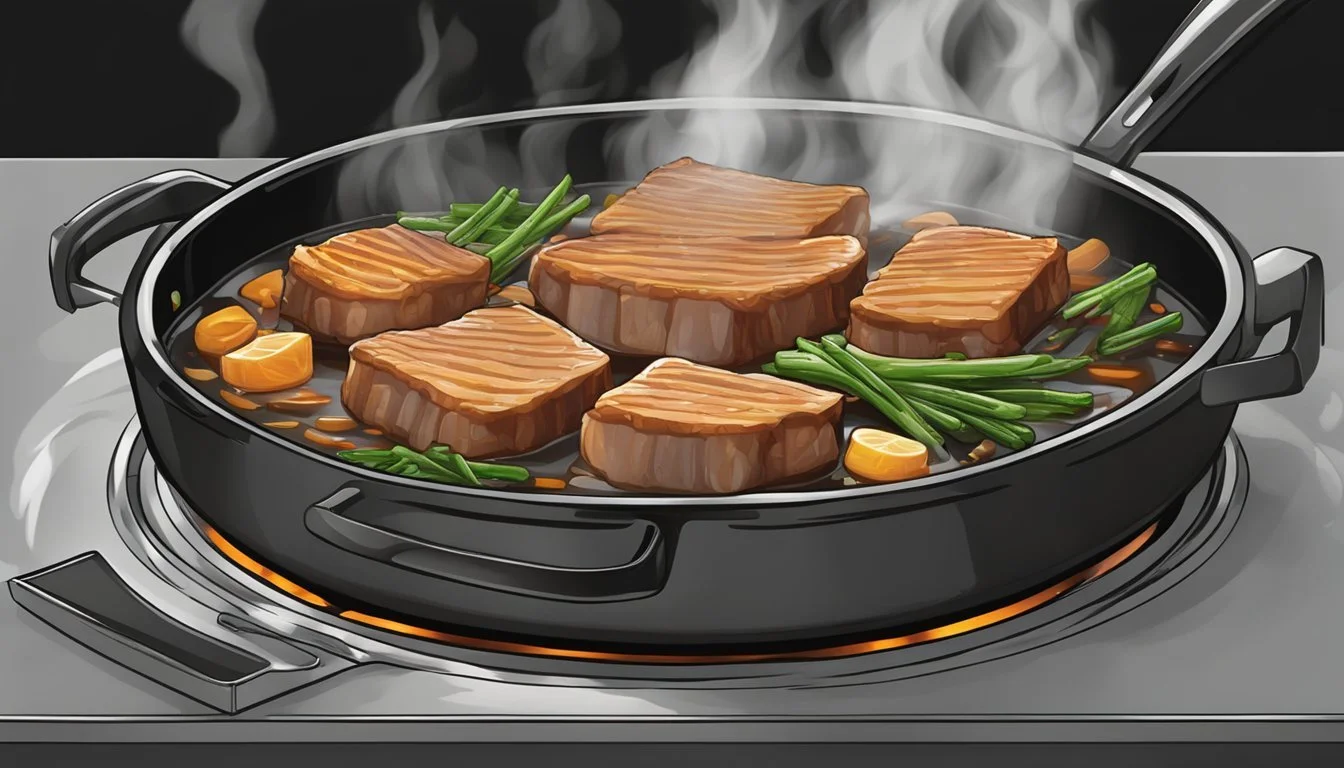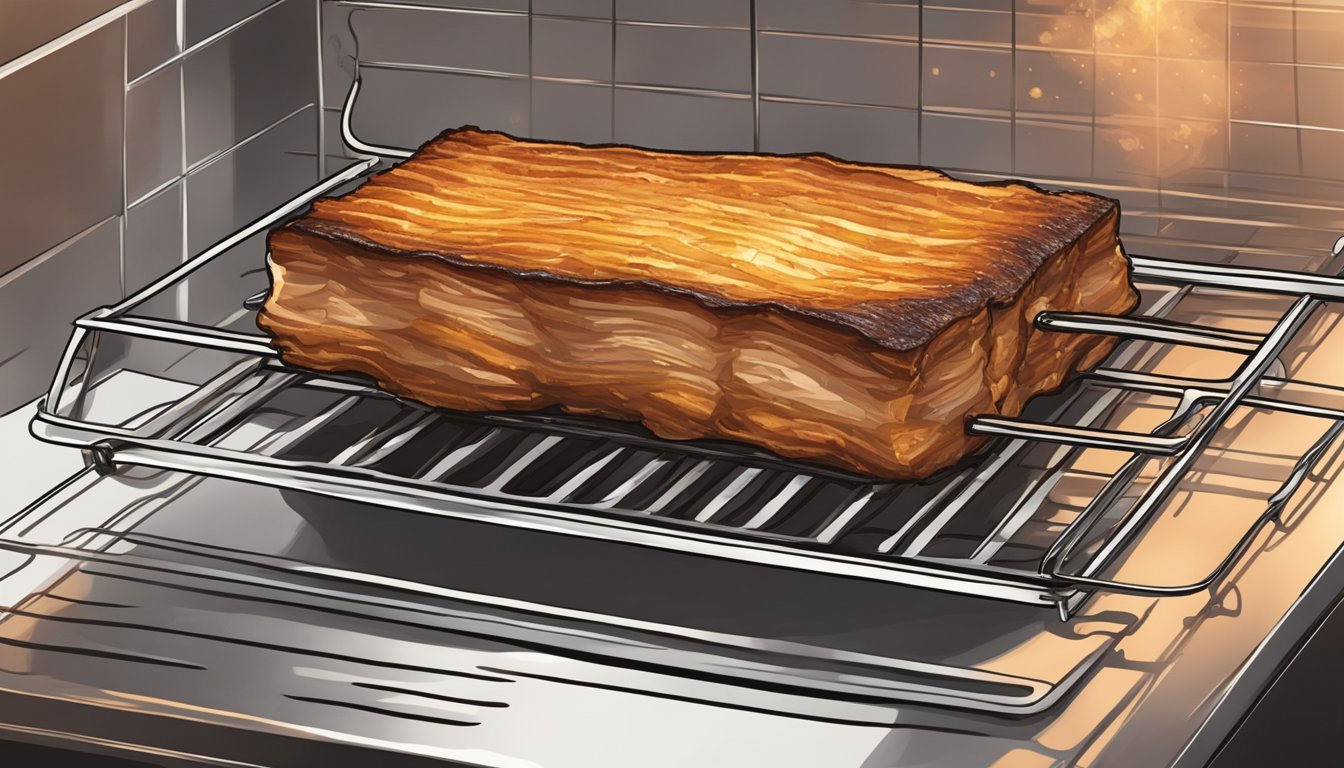Best Way to Reheat a Pork Belly while Keeping the Skin Crispy
Reheating pork belly (What wine goes well with pork belly?) while retaining its signature crispiness can be a culinary challenge. The key to success lies in a method that warms the meat through without compromising the texture of the skin. Oven reheating is widely regarded as a superior technique, as it provides an even distribution of heat and the ability to manage moisture levels effectively.
To ensure the pork belly remains moist and the skin achieves the desired crunch, it is advisable to separate the skin from the meat during the reheating process. Covering the meat with foil can prevent it from drying out. A hot oven, usually preheated to around 350°F to 400°F, crisps up the skin while gently warming the meat, striking a balance between preserving the juicy interior and maintaining the crisp exterior.
Understanding Pork Belly Reheating Fundamentals
Reheating pork belly properly is essential for maintaining the quality of the dish. One must consider the balance between retaining moisture and preserving the crispiness of the skin. It is generally recommended to use an oven, as this method evenly distributes heat and allows for better control.
Recommended Oven Temperature:
350°F (175°C) for gradual reheating
400°F (200°C) for a quicker process
Reheating Steps:
Preheat your oven to the chosen temperature.
Separate the skin from the meat if possible, for even reheating.
Wrap the pork belly meat in aluminum foil, optionally adding a spoonful of stock or water to prevent drying.
Place the meat on a baking tray in the lower part of the oven.
Cover the skin with foil and place on a separate baking sheet if separated.
Heat for 10-15 minutes depending on thickness and initial temperature.
Aluminum foil plays a crucial role in this process, as it traps moisture, ensuring that the meat stays juicy. Timing is also key; one should assess the pork belly's progress periodically to prevent overheating, which results in loss of moisture and texture.
For those seeking to restore the skin's crispiness, a final step may involve removing the foil and placing the meat under the broiler for a few minutes. Monitoring closely prevents burning and achieves the desired crunch.
By understanding these fundamental reheating methods, one can ensure that their leftovers are both flavorful and appetizing.
Preparation Before Reheating
Effective preparation maintains the pork belly's crispness and moisture. This involves proper thawing and employing moisture retention techniques before reheating.
Thawing Techniques for Frozen Pork Belly
If the pork belly is stored in the freezer, it should be transferred to the refrigerator to thaw slowly, which typically takes 12-24 hours, depending on size. Slow refrigeration thawing prevents the meat fibers from damaging, assuring that the pork belly remains juicy when reheated.
Step 1: Remove the pork belly from the freezer.
Step 2: Place it in an airtight container or wrap it in aluminum foil.
Step 3: Lay the wrapped pork belly in the fridge to thaw.
Moisture Retention Strategies
To keep the pork belly moist during reheating, one should wrap the meat (not the skin, to keep it crispy) in aluminum foil. Adding a small amount of water, broth, or stock inside the foil can also help to preserve the moisture content.
Before Reheating:
Separate the pork belly skin from the meat if possible.
Wrap the meat portion in aluminum foil.
Incorporate a tablespoon of water, broth, or stock into the aluminum foil before sealing.
Reheating Methods Compared
Selecting the appropriate reheating method is crucial to maintain the pork belly's delightful balance of crispy skin and tender meat.
Oven Reheating for Optimal Crispiness
The oven is ideal for reheating pork belly to achieve a crispy skin while keeping the meat tender. The process involves:
Preparation: Preheat the oven to 350°F (180°C) for a gentle reheat, or 400°F (200°C) for a quicker result.
Method: Place the pork belly skin-side up on a baking sheet. If the skin is separate, lay it on a different tray.
Timing: Heat for 10-15 minutes if at 350°F or shorter if at 400°F, checking for desired crispiness.
Microwave Reheating for Quickness
Microwave reheat can be fast but risks softening the crackling. Follow these steps:
Preparation: Place the slices in a microwave-safe dish.
Method: Cover with a lid or wrap and use short bursts of power to avoid overcooking.
Timing: Check every 30 seconds for warmth and texture.
Using Air Fryer for Effective Crispiness
Air fryers circulate hot air for a quick and even reheating that can preserve crispiness. To reheat:
Preparation: Preheat the air fryer to around 350°F (180°C).
Method: Place the pork belly in the air fryer basket, ensuring it is not overcrowded.
Timing: Reheat for a few minutes until the pork belly is evenly crispy.
Skillet Reheating for a Crunchy Texture
Skillet reheating works well for achieving a crunchy texture due to the direct dry heat:
Preparation: Heat the skillet with a small amount of oil.
Method: Lay the pork belly slices into the pan and press down lightly.
Timing: Cook each side for a few minutes until the exterior is satisfactorily crunchy.
Alternative Reheating Methods
For those seeking different results or using equipment other than the traditional oven or microwave:
Grill: Employing a grill can impart smokiness and crisp skin.
Toaster Oven: A toaster oven can function like a regular oven but is best for smaller portions.
Sous Vide: Ensures even reheating without overcooking, but will not crisp the skin.
Slow Cooker: Good for tender meat, though it won't provide crispiness to the skin.
Adapting the reheating method to the tools available and personal preferences will result in a perfectly reheated pork belly that's enjoyable and nearly as good as freshly cooked.
Dealing with Special Cases
In reheating pork belly, special cases pertain to unique preparations such as dishes incorporating pork belly as an ingredient and scenarios where added liquids are involved to enhance flavor or moisture.
Reheating Pork Belly Dishes
When dealing with dishes such as fried rice, tacos, burritos, or sandwiches that contain leftover pork belly, one must be mindful to balance the retention of the pork belly's texture while heating it through. For example, when reheating pork belly through incorporation into fried rice, the cook should:
Ensure the pork belly is diced into small, uniform pieces.
Sauté over a medium-high heat briefly, until just warmed to preserve texture.
For burritos or tacos, it might be best to heat the leftover pork belly separately to maintain its crispness before assembling it into the warmed tortillas.
Reheating Pork Belly with Added Liquids
When reheating variants like roast pork, pulled pork, or shredded pork belly with a glaze, marinade, or added liquids such as wine or apple juice, controlling condensation is crucial. To reheat such items:
Preheat oven to a moderate temperature, around 350°F (175°C).
Place the pork in an ovenproof dish and add a small amount of liquid to create moist conditions.
Cover tightly with aluminum foil to trap steam and prevent drying out.
For pork crackling, if incorporated with moist pork dishes, separately reheat it in a hotter part of the oven, uncovered, to maintain its crisp texture. This will prevent the crackling from becoming chewy due to condensation.
Post-Reheating Considerations
After reheating pork belly, the final quality depends on specific steps taken to restore its desirable characteristics and prevent common reheating errors.
Restoring the Crackling
To achieve the crackling texture of pork belly's skin, one should consider placing the reheated pork belly under the broiler for a brief period. A close watch is essential at this stage:
Broil for approximately 1-2 minutes, checking frequently.
Lightly brush the skin with oil to enhance crispiness if it appears dry.
The key is to watch the pork belly closely during broiling to prevent overcooking, which can lead to excessive dryness or even burning of the skin.
Avoiding Reheating Pitfalls
Several pitfalls can affect the texture and moisture content of reheated pork belly. The reheater should be aware of the following:
Timing: Avoid excessive heat exposure. Leftovers should be heated just enough to be warmed through.
Texture: To maintain moisture, one can cover the meat—excluding the skin—with foil.
Condensation: Avoid sealing the pork belly too tightly, as trapped steam can soften the skin, reducing crispiness.
It's important to avoid overcooking during reheating, as this can lead to a dry and tough texture. Monitoring and proper technique ensure the reheated pork belly retains its juiciness and crisp exterior.
Pork Belly Storage Tips
Proper storage is critical for maintaining the quality of pork belly before reheating. To preserve the freshness and flavor of pork belly, one should follow these guidelines:
Refrigeration:
Pork belly should be stored in the refrigerator if it will be consumed within a few days. For best results, wrap the pork belly tightly in food-grade plastic wrap or place it in an airtight container to prevent exposure to air and moisture, which can lead to spoilage.
Freezing:
For long-term storage, freezing pork belly is an effective method. It should be:
Portioned: Cut the pork belly into meal-sized pieces.
Wrapped: Wrap the portions in cling film or aluminum foil.
Bagged: Place wrapped portions in vacuum-sealed bags or zip-lock freezer bags to protect against freezer burn.
Labeled: Clearly label the bags with the date of freezing.
Thawing: When ready to use, thaw the pork belly in the refrigerator for 24 hours to ensure even and safe defrosting.
Vacuum-Sealed Bags:
If using vacuum-sealed bags for refrigeration or freezing, ensure the seal is complete to maximize freshness and extend the shelf life.
By adhering to these storage recommendations, the pork belly will be well-preserved for future use, ensuring it retains its textures and flavors upon reheating.
Final Thoughts
Reheating pork belly while preserving its delectable crispiness can be a culinary challenge. However, adhering to certain methods ensures that the meat remains juicy and the skin achieves that much-desired crunch. It's crucial to first preheat the oven to a temperature between 350°F and 400°F. This range is ideal for balancing the reheating process without drying out the pork.
When preparing the meat, separating the skin from the pork belly is advisable. This allows for each to be heated in a way that caters to their unique textures; the skin becomes crisp, while the meat stays tender. Covering the pork belly with aluminum foil is highly recommended to lock in moisture. A splash of stock or water added before sealing the foil can also help to maintain juiciness.
The pork belly should be placed in the oven for about 7 to 15 minutes, depending on the portion size. After heating through, removing it from the foil and placing the skin side up under a broiler or a grill for a short period will render the skin crispy again.
Lastly, one should always employ the tap test, gently knocking on the skin with a utensil. A satisfactory crackle signifies a perfectly reheated pork belly. By carefully following these steps, anyone can serve pork belly as if it were freshly cooked, with all the culinary qualities one savors in this classic dish.




